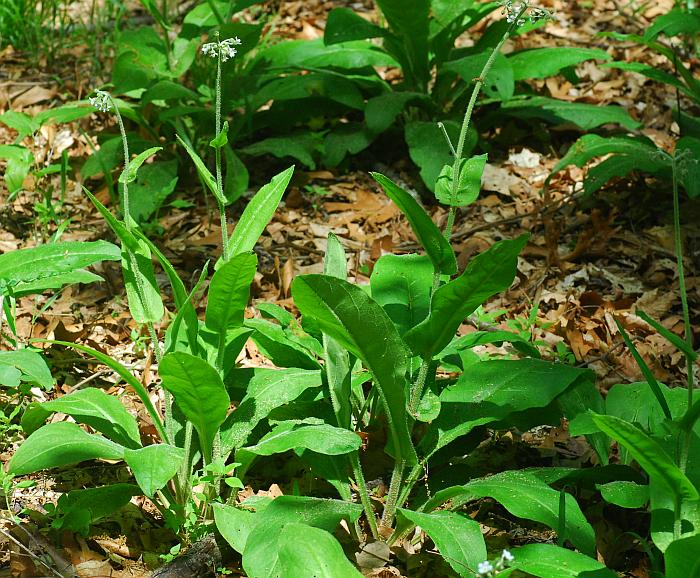Cynoglossum virginianum L.
Wild Comfrey, Houndstongue

Native
CC = 6
CW = 5
MOC = 28
© SRTurner
Cynoglossum virginianum L.Wild Comfrey, Houndstongue | |
 |
Native CC = 6 CW = 5 MOC = 28 |
© SRTurner |
|
Family - Boraginaceae Habit - Perennial forb, with stout, woody taproots or short, stout rhizomes, usually not producing an odor when bruised or crushed. Stems - Erect, to 90 cm, unbranched, moderately to densely pubescent with stiff, straight hairs and also much shorter, appressed hairs toward the tip, sometimes also with scattered patches of short, woolly hairs when young, leafless toward the tip.
Leaves - Basal and alternate, mainly located toward the plant base. Basal leaves relatively large, 10-30 cm long, 20-50 mm wide, the blade oblanceolate to spatulate, densely pubescent, entire, scabrous, tapered at the base into a long, winged petiole, grading abruptly into the stem leaves. Stem leaves sessile, entire, clasping, densely pubescent, lanceolate to oblanceolate, the lowermost leaves tapered at the base, the median leaves rounded to cordate at the base and usually strongly clasping the stem, rounded or angled to tapered to a usually sharply pointed tip, the surfaces moderately scabrous with stiff, more or less spreading, pustular-based hairs.
Inflorescence - Terminal loose scorpoid panicles, often appearing dichotomously branched, bractless, indeterminate. Inflorescence stalks hirsute.
Flowers - Calyces actinomorphic, 5-lobed nearly to the base, the lobes 2-5 mm long, spreading or somewhat reflexed, oblong-elliptic to broadly lanceolate. Corollas 4-7 mm long, 5-lobed, broadly funnelform to trumpet-shaped, actinomorphic, pale blue. Stamens 5, alternating with corolla lobes, adnate to corolla tube, mostly included. Style to 1.1mm long, arising from between nutlets.
Fruit - Schizocarps dividing into 4 nutlets, these 5-7 mm long, asymmetrically broadly obovoid, attached to the narrowly pyramidal gynobase at the tip (but appearing to be attached laterally toward the base), the attachment scar large and surrounded by a poorly developed rim, rounded or bluntly pointed at the tip, the surface with dense, stout, tapered, apically barbed tubercles, pale gray to nearly white or tan to dull brown.
Flowering - April - June. Habitat - Forests, open rocky woods, streambanks, pastures, ravines, ridges. Origin - Native to the U.S. Other info. - This distinctive species is found in Missouri predominantly in the southeastern quadrant. Outside of Missouri its range extends in a wide diagonal band from eastern Texas through New England. When in flower it is unmistakable, having big basal leaves and smallish inflorescences with random-pointing, pale blue flowers. The vegetative basal rosettes also have a characteristic appearance which is easy to recognize with a little practice. Photographs taken in Brown Summit, NC., 4-29-03, and in the Red Hills of Alabama, 3-25-06 (DETenaglia); also at St. Francois State Park, St. Francois County, MO, 5-5-2010, Valley View Glade Natural Area, Jefferson County, MO, 4-26-2012, Glassberg Conservation Area, Jefferson County, MO, 5-13-2013, Rockwoods Reservation, St. Louis County, MO, 5-11-2014, Canaan Conservation Area, Gasconade County, MO, 5-3-2016, and Don Robinson State Park, Jefferson County, MO, 5-18-2017 (SRTurner). |